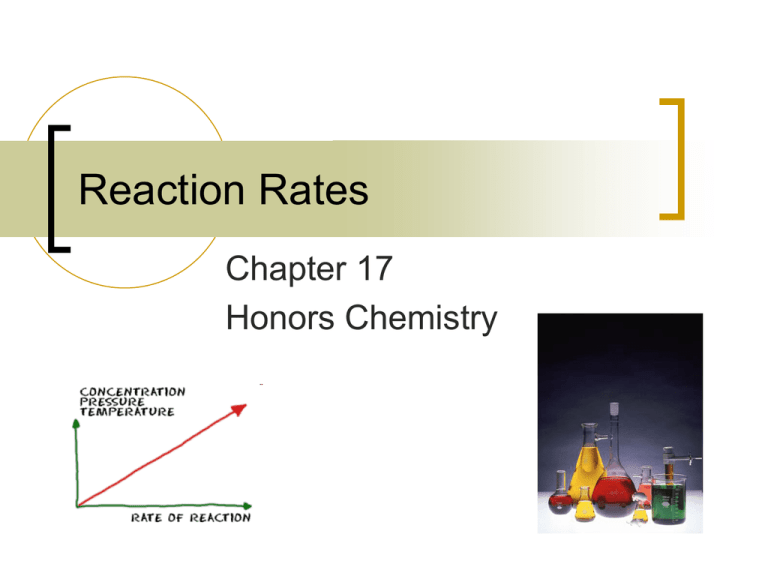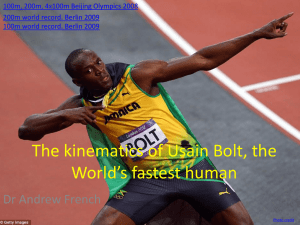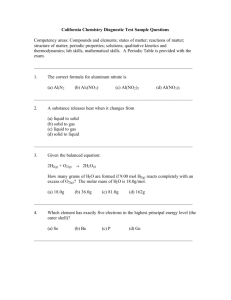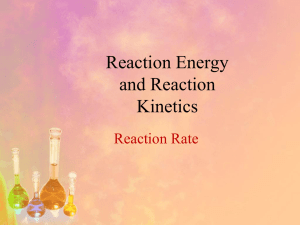Reaction Rates
advertisement

Reaction Rates Chapter 17 Honors Chemistry Reaction Rates Red Blue Reactions can be… FAST! Liquid hydrogen and oxygen reacting to launch a shuttle ..or S L O W Concrete hardening ..or S L O W Watching paint dry Expressing rxn rates in quantitative terms quantity Average rate t Example: Reaction data for the reaction between butyl chloride (C4H9Cl) and water is given below. Calculate the average reaction rate over this time period expressed as moles of C4H9Cl consumed per liter per second. quantity Average rate t [C4H9Cl]final - [C4H9Cl]initial tfinal tinitial mol (0.100 mol 0.220 L L ) (4.00 s - 0.00 s) Table 17-1: Molar Concentration [C4H9Cl] at t=0.00 s [C4H9Cl] at t=4.00 s 0.220 M 0.100 M -0.120 mol L 4.00 s -0.0300 mol L s Collision Theory Atoms, ions and molecules must collide in order to react. Reacting substances must collide with the correct orientation. Reacting substances must collide with sufficient energy to form the activated complex. Orientation and the activated complex Analogy: if you start with two separate paperclips (reactants) and you wish to link them together (products), not only must the paperclips come into contact, but they also must collide with a specific orientation. Orientation and the activated complex Biological example: ENZYMES You’ll learn much more about this next year Activation energy and reaction Only collisions with enough energy to react form products Activation energy and reaction Activation energy and reaction Another example reactants Activated complex (also called transition state) products Does ∆G tell us anything about rxn rate? NO If a reaction is spontaneous, it does not follow that it is fast or slow. Thus, a new branch of chemistry… kinetics Factors affecting reaction rates 1) 2) 3) 4) 5) 6) The nature of the reactants Concentration Pressure (gases only) Surface area Temperature Catalysts NATURE OF REACTANTS Some elements/compounds are more reactive than others FAST sodium in water (alkali metals are VERY reactive) NATURE OF REACTANTS Some elements/compounds are more reactive than others SLOW Rusting of iron (it takes time for moisture in the air to oxidize the metal… process can be sped up if salt is present, but will still not react as fast as sodium and water) CONCENTRATION As concentration ↑, frequency of collisions ↑, and therefore rxn rate ↑ PRESSURE (gases) For gases, increasing pressure creates the same effect as increasing concentration SURFACE AREA As surface area ↑, rxn rate ↑ ← slow fast TEMPERATURE: Generally, ↑ temp = ↑ rate Why? Higher temp = faster molecular motion = more collisions and more energy Analogy: imagine that you are baby-sitting a bunch of per collision = faster rxn 6 year olds. You put them in a yard and you let them run around. Every now and then a couple of kids will run into each other. Now imagine that you decide to feed them some sugar. What happens? They run around faster and of course there are many more collisions. Not only that, the collisions are likely to be a lot harder/more intense. CATALYST Catalyst: a substance that speeds up the rate of a reaction without being consumed in the reaction. Provides an easier way to react Lowers the activation energy Enzyme = biological catalyst CATALYST Adding a catalyst speeds up the rxn by lowering the activation energy Reaction Rate Laws The equation that expresses the mathematical relationship between the rate of a chemical reaction and the concentration of reactants is a rate law. For the reaction : A B Rate k[A] *where k is a constant specific to this reaction Reaction Order The reaction order for a reactant defines how the rate is affected by the concentration of that reactant. The overall reaction order of a chemical reaction is the sum of the orders for the individual reactants in the rate law. Reaction Order The rate law for most reactions has the general form…. Rate = k[reactant 1]m[reactant 2]n… The exponents m and n are called reaction orders. Their sum (m + n) is called the overall reaction order. Reaction Order For the reaction aA + bB products Rate = k[A]m[B]n where m and n are the reaction orders for A and B respectively Only if the rxn between A and B happens in a single step (with a single activated complex… which is unlikely) does m=a and n=b. Thus, the values of m and n must be determined experimentally!!! Reaction Order For the reaction aA + bB products Rate = k[A]m[B]n where m and n are the reaction orders for A and B respectively Rate laws cannot be predicted by looking at a balanced chemical equation. Finding the rate law The most common method for experimentally determining the differential rate law is the method of initial rates. In this method several experiments are run at different initial concentrations and the instantaneous rates are determined for each at the same value of time (as near t = 0 as possible) Using Initial Rates to Determine the Form of the Rate Law A + B C Exp # [A] [B] Initial Rate (M/s) 1 .100M .100M 4x10-5 2 .100M .200M 4x10-5 3 .200M .100M 16x10-5 From this data, find the form of the rate law.. Rate = k[A]m[B]n Exp # [A] [B] Initial Rate (M/s) 1 .100M .100M 4x10-5 2 .100M .200M 4x10-5 3 .200M .100M 16x10-5 Rate = k[A]m[B]n Rate 2 4 10 5 k [.100]m [.200]n 5 m Rate 1 4 10 k [.100] [.100]n [.200]n 1 [.100]n 12 n n=0 Exp # [A] [B] Initial Rate (M/s) 1 .100M .100M 4x10-5 2 .100M .200M 4x10-5 3 .200M .100M 16x10-5 Rate = k[A]m[B]n Rate 3 16 10 5 k [.200]m [.100]n 5 m Rate 1 4 10 k [.100] [.100]n [.200]m 4 m [.100] 4 2m m=2 Exp # [A] [B] 1 .100M .100M 4x10-5 2 .100M .200M 4x10-5 3 .200M .100M 16x10-5 Rate = k[A]m[B]n Rate = k[A]2[B]0 Rate = k [A]2 Initial Rate (M/s) Exp # [A] [B] 1 .100M .100M 4x10-5 2 .100M .200M 4x10-5 3 .200M .100M 16x10-5 Now, solve for k… rate k [A]2 [B ]0 Initial Rate (M/s) Rate = k [A]2 4 105 3 4 10 [.100]2 Rate = 4x10-3 [A]2 Knowing rate laws and rate orders helps us predict how the reaction will proceed over time Application: Radioactive decay is a first order reaction Half life is constant over time Allows us to date fossils, etc. Reaction Mechanisms Most chemical reactions consist of a sequence of two or more steps (or simpler reactions). These add together to create the overall reaction equation. Generally, some steps will be fast and others will be slow. The slow step is the rate determining step. Example: The reaction between NO2 and CO has the overall reaction: NO2 + CO NO + CO2 A study of the kinetics of this reaction revealed the rate law for the reaction is. Rate = k[NO2]2 This Rate Law requires that the slow step of the reaction involves a collision between two NO2 molecules. How can this be a step in the seemingly simple reaction above? NO2 + CO NO + CO2 Further study of this reaction established that two NO2 molecules can react as follows… NO2 + NO2 NO3 + NO NO3 is a highly reactive material which is capable of transferring an oxygen atom. NO3 + CO NO2 + CO2 2NO2 + NO3 + CO NO2 + NO3 + NO + CO2 NO2 + CO NO + CO2 NO2 + CO NO + CO2 The first equations sets the rate law, so it must be the slow one. NO2 + NO2 NO3 + NO slow NO3 + CO NO2 + CO2 fast NO2 + CO NO + CO2 Remember, the rate law only provides information about the slowest reaction in the mechanism.






